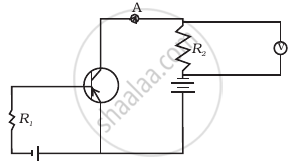Advertisements
Advertisements
प्रश्न
Explain how a potential barrier is developed in a p-n junction diode.
उत्तर १
During the formation of p-n junction, and due to the concentration gradient across p-, and n- sides, holes
diffuse from p-side to n-side (p → n) and electrons diffuse from n-side to p-side (n → p). This motion of charge carries gives rise to diffusion current across the junction. When an electron diffuses from n → p, it leaves behind an ionised donor on n-side. This ionised donor (positive charge) is immobile as it is bonded to the surrounding atoms. As the electrons continue to diffuse from n → p, a layer of positive charge (or positive space-charge region) on n-side of the junction is developed.
उत्तर २
In a p-n junction diode, holes are the majority carriers on the p side whereas electrons are the majority carriers on the n-side of the semiconductor. Due to the diffusion of majority carriers from p-region to n-region, the p-region becomes less positive and n-region becomes less negative. An imaginary voltage is developed across the junction which prevents further movement of majority carriers across the junction. The voltage so developed is known as the potential barrier.
संबंधित प्रश्न
Explain with the help of a diagram, how depletion region and potential barrier are formed in a junction diode.
With what considerations in view, a photodiode is fabricated? State its working with the help of a suitable diagram.
Even though the current in the forward bias is known to be more than in the reverse bias, yet the photodiode works in reverse bias. What is the reason?
A p-n photodiode is fabricated from a semiconductor with band gap of 2.8 eV. Can it detect a wavelength of 6000 nm?
What happens to the width of depletion player of a p-n junction when it is (i) forward biased, (ii) reverse biased?
Draw the circuit arrangement for studying the V-I characteristics of a p-n junction diode in reverse bias. Plot the V-I characteristics in this case.
Explain photodiode.
What is the magnitude of the potential barrier across a Ge p-n junction?
In Figure, assuming the diodes to be ideal ______.

If the resistance R1 is increased (Figure), how will the readings of the ammeter and voltmeter change?

What energy conversion takes place in a solar cell?
